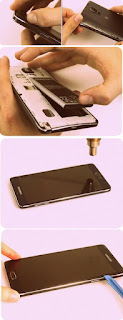 Samsung Galaxy Note 4 DISASSEMBLING PROCEDURE
Samsung Galaxy Note 4 DISASSEMBLING PROCEDURE
How
to remove the battery – How to replace the display – How to replace the Micro
USB port - Samsung Galaxy Note 4
How
to remove Rear Case
Insert
a fingernail or plastic opening tool into the divot to the left of the
rear-facing camera.
Gently pry and twist the flexible rear cover off the back of the phone.
Gently pry and twist the flexible rear cover off the back of the phone.
Insert
a fingernail or plastic opening tool into the recess in the bottom right corner
of the battery and lift upward.
How
to remove Display Assembly
NOTE:
It is suggested to remove the battery, S Pen, SD Card, and SIM card (if your
phone uses a SIM card).
Heat at a low degree such as less than 80 degree because the adhesive is not so strong. Heat makes it's easy, but you also can gave up heating and cut the adhesive sticker directly. Please be careful.
Heat at a low degree such as less than 80 degree because the adhesive is not so strong. Heat makes it's easy, but you also can gave up heating and cut the adhesive sticker directly. Please be careful.
Cut
LCD screen adhesive sticker carefully and slowly.
Be
very careful once you get to the bottom part of the phone, take your time, and
be very careful not to cut the flex of the Back and Menu buttons. Use the next
set of images to examine how close they are to the edge so you don't
accidentally cut them.
Insert
the spudger underneath the LCD to cut the adhesive in the middle part. The
adhesive is strong so make sure you are underneath the copper insulation before
separating.
Notice
1: The adhesive is in the red line.
Notice
2: If you insert the spudger from right side, keep the length of the tool in
less than 2.2cm, which is for avoiding damaging the home button flex.
Notice 3: If you insert the spudger from left side, keep the length of the tool in less than 4.4cm for the same reason.
Notice 3: If you insert the spudger from left side, keep the length of the tool in less than 4.4cm for the same reason.
Notice
4: Pay attention to the part with LCD screen flex. When you cut the adhesive,
leave the top part alone to avoid damage the flex. But if it's the broken
screen, you don't need to worry so much.
Be
careful with the bottom side because there are the soft keys. If the adhesive
in the red line don't function any more when you place the new LCD screen, you
can choose to use the 3M double side tape. It can help to fasten the new screen
together with the LCD screen sticker.
Release
S Pen touch sensor film connector and LCD screen connector.
Remove
the LCD screen finally.
How
to remove Micro-USB
Remove
back cover easily. And take away the battery, SIM card and S Pen by the way.
Remove
all together 16 screws from middle housing.
Free
the clasps along the battery slot. And the push the front assembly out from
middle housing with effort.
We
can see the USB board but we can't tear it down directly. Because 1. The USB
board flex connector is connecting on the back of the motherboard. 2. If want
to remove motherboard, the LCD screen need to be removed at first. 3. The USB
board assembly comes with two touch keys together but they are placed under the
touch panel. So we have to remove the motherboard and LCD screen at first next.
Remove
two pcs of signal flex cable and two screws which securing USB board and
motherboard.
Release
all the connectors connecting with motherboard.
Pry
up the motherboard and release USB board connector from back.
Loosen
the touch keys from adhesive at first. And then pry up and remove the USB board
finally.



